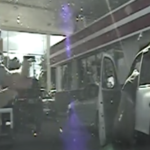Surviving a Police Encounter – Part 3 Communicating with the Officer
Surviving a Police Encounter
Part 3: Communicating with the officer
 South Carolina Highway Patrol trooper Sean Groubert stopped Levar Jones in the parking lot of a gas station for a seat belt violation. Jones was just stepping out of his vehicle when Groubert pulled up in his cruiser. “Can I see your license, please?” the trooper asks. Jones pats at his back pocket and then turns suddenly and reaches into his vehicle.
South Carolina Highway Patrol trooper Sean Groubert stopped Levar Jones in the parking lot of a gas station for a seat belt violation. Jones was just stepping out of his vehicle when Groubert pulled up in his cruiser. “Can I see your license, please?” the trooper asks. Jones pats at his back pocket and then turns suddenly and reaches into his vehicle.
What is the trooper thinking at this moment? In Part 2 of this series, we told you about Deputy Kyle Dinkheller, murdered by a motorist who reached into his vehicle and grabbed an Iver Johnson M1 carbine. We also described horrific body camera footage of New Mexico State Police Officer Darian Jarrott being gunned down by a motorist who exited his vehicle with an AR-15-style rifle.
Lots of Americans have guns — many of them legally, some illegally. Often they’re easy to conceal, and a firearm can be introduced to a patrol stop faster than an officer can respond. In Albuquerque, New Mexico, officer Daniel Webster was trying to handcuff a motorcyclist during a traffic stop when the cyclist pulled a pistol from his jacket and fired at the officer who died days later from his injuries. Webster had almost no time to react to the deadly threat.
Perhaps, tragic incidents similar to these were top of mind for Trooper Groubert when he saw Lavar Jones reaching suddenly into his vehicle. “Get out of the car!” Groubert screams. Jones turns, and the trooper fires, striking the motorist in the hip. Jones throws his hands in the air. “I just got my license,” he says. “You said ‘get my license.’” Jones was unarmed. Luckily, he survived his injuries.
Within days, the South Carolina Highway Patrol fired Groubert, who eventually pled guilty to charges of aggravated assault and battery. During his sentencing hearing, Groubert apologized to Jones. “I made a horrible mistake the day I shot you and I owe you an apology and I deserve to be punished. You did nothing wrong and I screwed up, plain and simple. I pray for you every night.”
Everyone agrees Jones did nothing wrong, even the officer who shot him. That is small consolation to Jones who, according to ABC 4 News, told the court that he “no longer trusts law enforcement officers.”
Looking at this encounter with the mission of de-escalating encounters with law enforcement, here’s a controversial idea: Even though the officer was at fault and Jones did nothing wrong, could Jones could have done something — or said something — that might have led the encounter to a different outcome?
Retired Oklahoma City Police Officer Stan Campbell founded D.O.P.E. the Movement to help citizens and law enforcement officers alike understand the importance of De-escalating Officer Patrol Encounters. Stan stresses that the onus for reducing officer-involved shootings is on law enforcement agencies, but he says there are things civilians can do to increase their odds of surviving a law enforcement encounter with their rights intact — even if they encounter a poorly trained officer who makes mistakes.
Stan talks about “The Three Cs”: Caring, Communication, and Compliance. In Part 2 of our series, we described “caring” in terms of demonstrating an understanding that traffic stops are also stressful for law enforcement officers, and we recommended taking actions that let the officer know you are not a threat. Pulling over as soon as you recognize you are being stopped and keeping your hands clearly visible are two key ways to demonstrate you care about an officer’s safety. “When you make the encounter safe for the officer; it’s going to be safer for you,” Stan says.How you communicate with an officer during a traffic stop can go a long way to making the encounter safe for both parties.
Lorenzo Banks is a criminal defense and civil rights attorney in Oklahoma City, and he’s joined forces with Stan Campbell to spread the word about D.O.P.E. the Movement. He recommends that citizens speak to officers in a calm, respectful tone. He says it’s human nature to match the tone of the person your speaking to, and just the tone of your voice can de-escalate the tension during a police encounter.
In the encounter between Groubert and Jones, the motorist never really had a chance to establish a “calm, respectful tone,” but Groubert’s over-reaction to Jones’s movement into his vehicle demonstrates the trooper misinterpreted his actions. It highlights the importance of communicating with the officer, demonstrating that you understand his or her orders, and describing how you intend to follow those orders.
Lorenzo offers an example: “Hey officer, I know you’re asking for my driver’s license and registration. My registration is actually in the glove box on my right. I’m going to leave my left hand on the steering wheel and reach forward. Is that okay?” Stan teaches the same and adds, “You should intentionally move slow even after you have informed the officer of your plan to make a move.”
Had Lavar Jones told the trooper that his license was in his vehicle, and better yet, asked for the trooper’s permission to reach for it, it is very likely the encounter would have ended without Jones being shot in the hip. Did Jones do anything wrong? No. Did the trooper give a bad command under the circumstances and over-react? Absolutely. However, none of that really matters after the shooting is over; Lavar Jones cannot be “unshot,” no matter how many years the trooper spends in prison.
Beyond just helping citizens survive law enforcement encounters, D.O.P.E. the Movement is dedicated to helping citizens keep their rights intact. Communication, beyond defusing a potentially life-threatening situation, can be used to preserve your rights. If an officer ever fails to make it clear why you’ve been stopped, Stan says you can ask, “Hey, am I free to leave? Are you investigating a crime? Do you have probable cause that I’ve committed a crime?” If an officer doesn’t have legal cause to detain you, they are obligated to let you go, and communicating that you understand your rights is the first step in making sure an officer doesn’t violate your rights.
When it comes to your rights and the concept of communication, Attorney Lorenzo Banks also reminds us that the Constitution affords us the right not to communicate — or more to the point, the right to remain silent. An officer can ask you questions, but you are not obligated to answer them. If you choose not to answer an officer’s questions, it’s best to do so in a way that indicates you are asserting your Fifth Amendment rights. But do it kindly. “There is a way to respectfully assert your rights,” Lorenzo says.
Just because you don’t have to answer an officer’s question, however, doesn’t mean you aren’t required to comply with an officer’s lawful orders. In Part 4 of our series, we’ll talk about the importance of civilian compliance during a police encounter, and the safe way for citizens to preserve their rights when officers overstep their legal authority.

SHAWN VINCENT – LITIGATION CONSULTANT
Shawn Vincent is a litigation consultant who helps select
juries in self-defense cases, and he manages public interest
of high-profile legal matters. If you have any questions for
Shawn, or would like topic specific articles, please send your
request to dopethemovementinfo@gmail.com attention Shawn Vincent Articles.
Leave a Comment
You must be logged in to post a comment.


